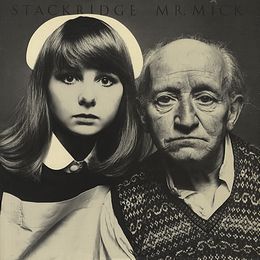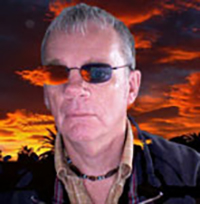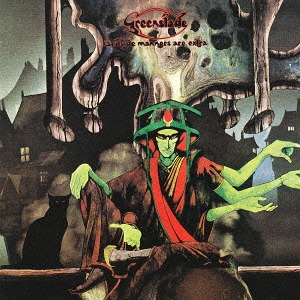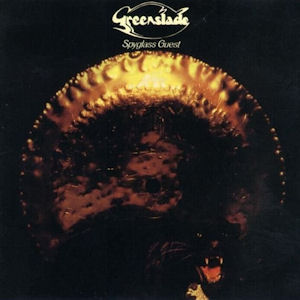Related Research Articles

The Mellotron is an electro-mechanical musical instrument developed in Birmingham, England, in 1963. It is played by pressing its keys, each of which causes a length of magnetic tape to contact a capstan, which pulls it across a playback head. As the key is released, the tape is retracted by a spring to its initial position. Different portions of the tape can be played to access different sounds.

Hans Florian Zimmer is a German film score composer and music producer. He has won two Oscars and four Grammys, and has been nominated for three Emmys and a Tony. Zimmer was also named on the list of Top 100 Living Geniuses, published by The Daily Telegraph in 2007.

Anthony George Banks is an English musician, songwriter, singer and film composer primarily known as the keyboardist and founding member of the rock band Genesis. Banks is also a prolific solo artist, releasing six solo studio albums that range through progressive rock, pop, and classical music.
XYZ were a short-lived English rock supergroup. The name XYZ is taken from "eX-Yes-Zeppelin" as the group consisted of ex-Led Zeppelin guitarist Jimmy Page, along with ex-Yes members Chris Squire and Alan White (drums).
John Alfred Mandel was an American composer and arranger of popular songs, film music and jazz. The musicians he worked with include Count Basie, Frank Sinatra, Peggy Lee, Anita O'Day, Barbra Streisand, Tony Bennett, Diane Schuur and Shirley Horn. He won five Grammy Awards, from 17 nominations; his first nomination was for his debut film score for the multi-nominated 1958 film I Want to Live!

Stanley William Tracey was a British jazz pianist and composer, whose most important influences were Duke Ellington and Thelonious Monk. Tracey's best known recording is the 1965 album Jazz Suite Inspired by Dylan Thomas's "Under Milk Wood", which is based on the BBC radio drama Under Milk Wood, by Dylan Thomas.

Stackridge were a British rock group which had their greatest success in the early 1970s.

Greenslade were an English progressive rock band, formed in the autumn of 1972 by keyboard player Dave Greenslade and bassist Tony Reeves, with keyboardist Dave Lawson and drummer Andrew McCulloch.

David John Greenslade is an English composer and keyboard player. He has played with Colosseum from the beginning in 1968 until the farewell concert in 2015 and also from 1973 in his own band, Greenslade, and others including If and Chris Farlowe's Thunderbirds.
Laurence Reginald Ward Johnson was an English composer and bandleader who wrote scores for dozens of film and television series, described as "one of the most highly regarded arrangers of big-band swing and pop music" in England. Much of Johnson's music was written for the KPM music library, for which he composed and conducted between 1960 and 1965.
Anthony George Coe was an English jazz musician who played clarinet, bass clarinet, and flute as well as soprano, alto, and tenor saxophones.

Mr. Mick is the fifth studio album released by the British rock group Stackridge in 1976. It originally was released in the UK by The Rocket Record Company, and its catalogue number was ROLL 3. This was the first album by Stackridge to go unreleased in the United States.

Derek John "Blue" Weaver is a Welsh rock keyboardist, session musician, songwriter and record producer.

Bedside Manners Are Extra is the second studio album by English progressive rock band Greenslade, released in November 1973 by Warner Bros. Records. The cover artwork was designed by renowned artist Roger Dean, who had previously collaborated with the band on their debut album.

Greenslade is an eponymous studio album by British progressive rock band Greenslade, released on the Warner Bros. label in 1973, and their first album. The artwork for the album cover is by Roger Dean. The album has seven tracks comprising six songs and one instrumental with a vocal track.

Spyglass Guest is the third studio album by British progressive rock band Greenslade, released in 1974. It is their most commercially successful album to date, having reached number 34 in the UK Albums Chart. It was the final recording bassist Tony Reeves made with the group, leaving Greenslade shortly after the LP was completed.

Keith Gemmell was a British musician. He played saxophone, clarinet, and flute, and was best known for being a member of art rock band Audience from 1969 to 1972 and from 2004 to 2016. He was also a musical arranger and composer, published digital sheet music, wrote articles for the UK publication Music Tech Magazine, and was the author of several books including the best-seller Cubase Tips & Tricks.
The Alan Bown Set later known as The Alan Bown! or just Alan Bown, were a British band of the 1960s and 1970s whose music evolved from jazz and blues through soul and rhythm and blues and ended up as psychedelia and progressive rock. The band achieved limited chart success and is best known for the role it played in developing the careers of numerous musicians including Mel Collins, John Helliwell, Robert Palmer, Jess Roden and Dougie Thomson.

Time and Tide is the fourth studio album of the British progressive rock band Greenslade, released in 1975 on Warner Bros. Records. The artwork for the album cover is by Patrick Woodroffe. The album was released in the US on the Mercury Records label.
David Snell is a British harpist, composer and conductor who has worked across a wide range of genres, from jazz, pop and soundtracks through to library music and classical concert works.
References
- 1 2 "Dave Lawson - The Web/Samurai/Greenslade Interview". The Self Portrait Gospel.
- ↑ "Dave Lawson". strawberrybricks.com.
- 1 2 3 4 5 6 "David Lawson Music – Composer and Sound Designer". Davelawson.org. Retrieved 18 March 2014.
- 1 2 Roberts, David (2006). British Hit Singles & Albums (19th ed.). London: Guinness World Records Limited. p. 236. ISBN 1-904994-10-5.
- 1 2 Romano, W. 2010, Mountains Come Out of the Sky: The Illustrated History of Prog Rock, Backbeat Books, ISBN 978-0879309916